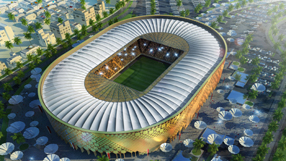Qatar heat 'could' change match format

Michael Beavon, a director of Arup Associates who helped to develop the zero-carbon solar technology that will cool the 12 stadiums, told delegates at the Qatar Infrastructure Conference in London that the air-cooling would maintain a comfortable temperature of around 24 degrees Celsius in the stadiums.
"There is a moderate risk of heat injury to the players between 24C-29C but if you go above that you have high and extreme risk of injury.
"The one thing FIFA do say, although it is for guidance, is if it's 32C they will stop a match and play three 30-minute thirds rather than two 45-minute halves.
"The reason would be to re-hydrate the players before they could carry on playing. That of course would play havoc with TV schedules and those kind of things.
"The commitment from Qatar was to provide conditions in the moderate band, so that matches would go ahead and be played as normal. Matches have to be played at an acceptable temperature and in safety so that FIFA do not intervene."
A FIFA spokesman told Reuters: "This possibility has not been discussed. In any case, this would require a change in the Laws of the Game, and therefore would have to be analysed and approved by the International Football Association Board (IFAB) in the first place."
The laws of the game state that a match will last for two periods of 45 minutes, unless otherwise mutually agreed by the referee and both teams, though any changes to the usual 45-minute halves have always been to reduce the playing time for age-group matches.
The best features, fun and footballing quizzes, straight to your inbox every week.
INJURY RISK
Beavon said that when FIFA's inspection team evaluating the World Cup bids for 2022 visited Qatar in September last year, the external temperature was 44 Celsius - very similar to the external conditions there will be at the World Cup.
"During those conditions we had to demonstrate to them that we could create a comfortable, open-air environment, using zero carbon technologies in the stadiums.
"There are no actual requirements for the players, but 70 percent of their comfort issues surround heat and humidity and we have to keep the heat and humidity at bay.
"Players have to sweat their heat off when they are running around, and in this environment there is a risk of injury when you go above certain temperatures.
"I think FIFA are doing the right thing in having a contingency if the temperature was to rise above 29C in the stadium. It is very forward-thinking of them to take the players' safety into account, but I am convinced that the cooling systems will be 100 percent reliable.
"Over the next 11 years the technology will be improved and of course there will be a back-up system. With a solar-powered system it is almost 100 percent guaranteed now, and we have no real fears that it would fail."
Qatar was controversially awarded the finals last December, beating off bids from Australia, Japan, South Korea and the United States in the process.
The two-day conferenc
